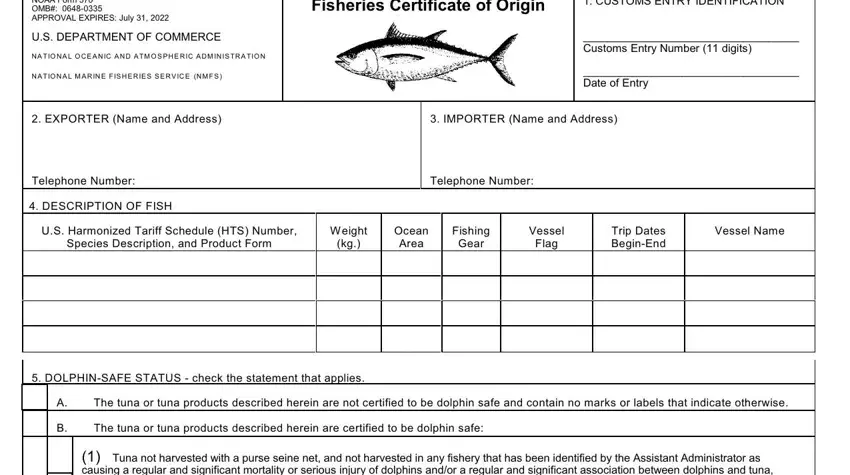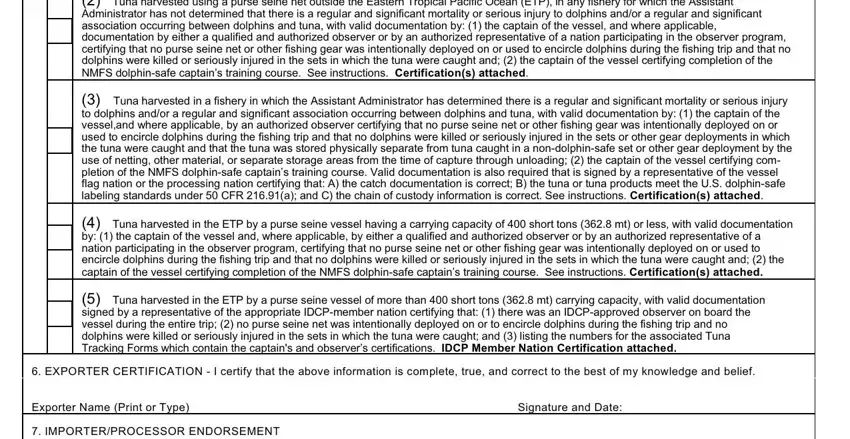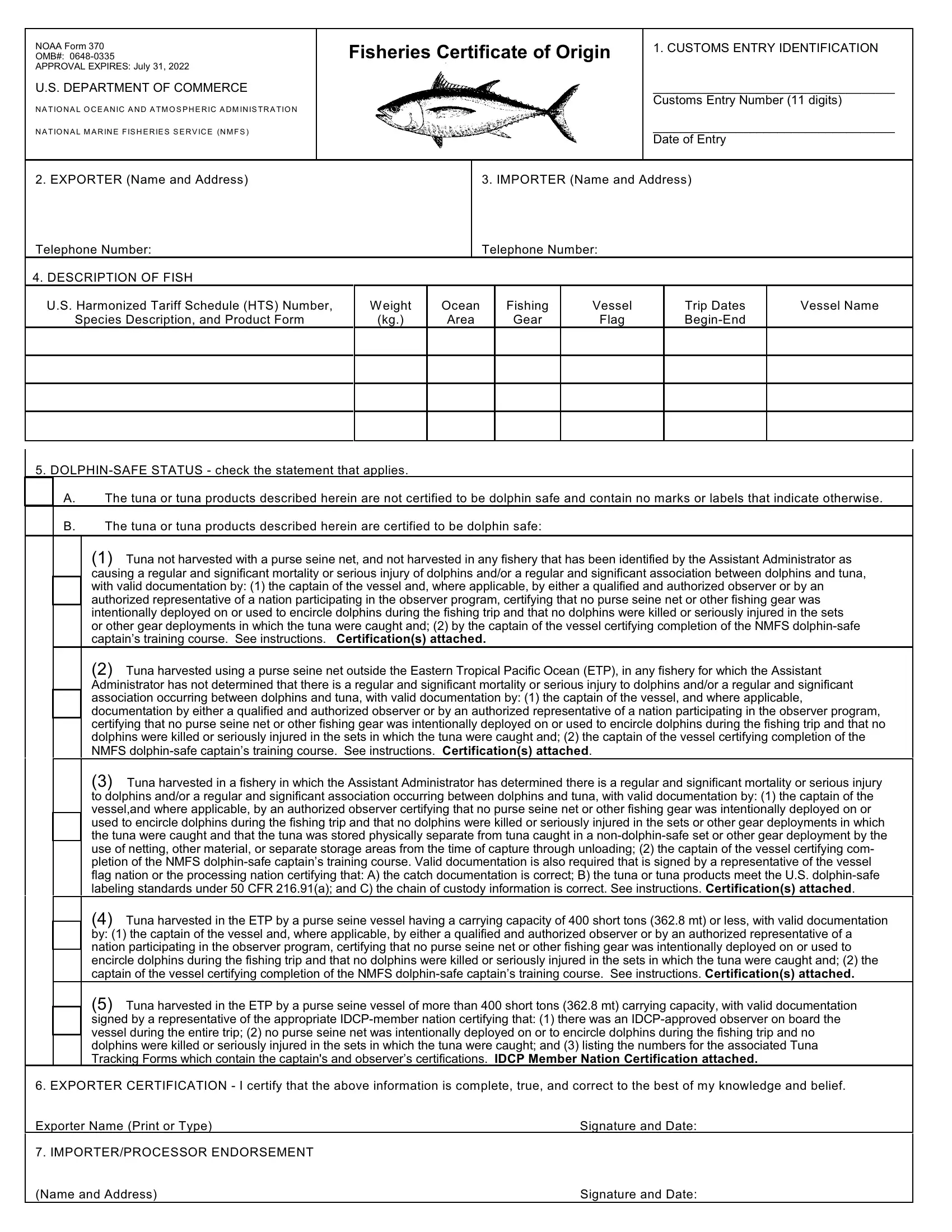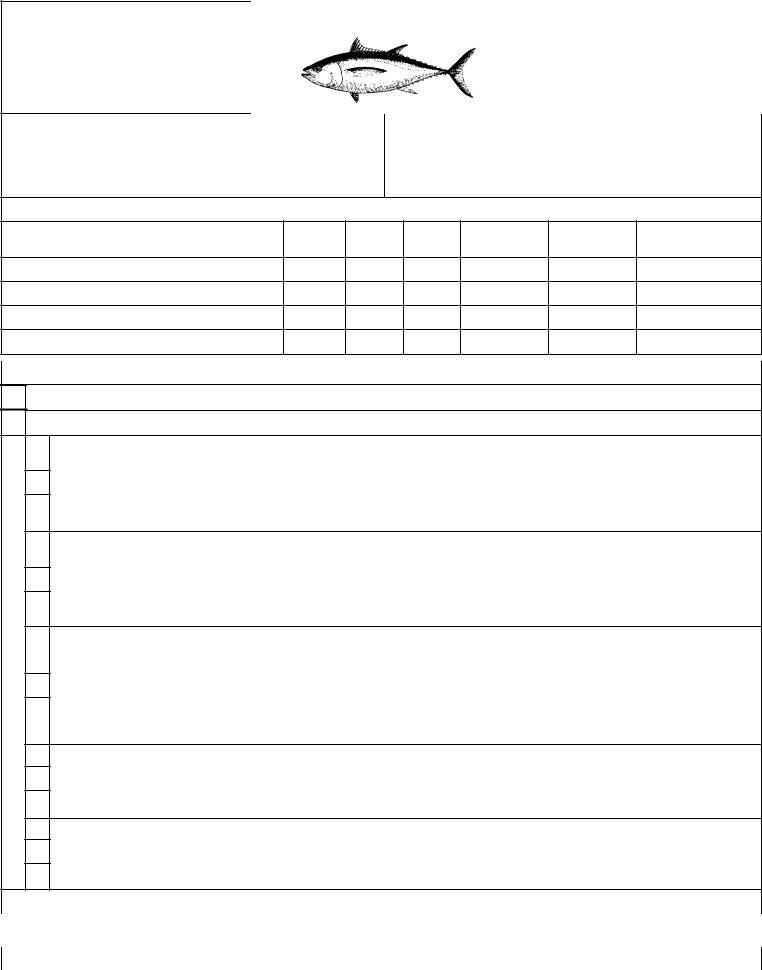NOAA Form 370
OMB#: 0648-0335
APPROVAL EXPIRES: July 31, 2022
U.S. DEPARTMENT OF COMMERCE
N A T IO N A L O C E A N IC A N D A TM O S P H E R IC A D M IN IS T R A T IO N
N A T IO N A L M A R IN E F IS H E R IE S S E R V IC E (N M F S )
2.EXPORTER (Name and Address)
Telephone Number:
Fisheries Certificate of Origin |
1. CUSTOMS ENTRY IDENTIFICATION |
|
|
___________________________________ |
|
Customs Entry Number (11 digits) |
|
___________________________________ |
|
Date of Entry |
|
|
3.IMPORTER (Name and Address)
Telephone Number:
U.S. Harmonized Tariff Schedule (HTS) Number,
Species Description, and Product Form
5. DOLPHIN-SAFE STATUS - check the statement that applies.
A. The tuna or tuna products described herein are not certified to be dolphin safe and contain no marks or labels that indicate otherwise.
B.The tuna or tuna products described herein are certified to be dolphin safe:
(1)Tuna not harvested with a purse seine net, and not harvested in any fishery that has been identified by the Assistant Administrator as causing a regular and significant mortality or serious injury of dolphins and/or a regular and significant association between dolphins and tuna, with valid documentation by: (1) the captain of the vessel and, where applicable, by either a qualified and authorized observer or by an authorized representative of a nation participating in the observer program, certifying that no purse seine net or other fishing gear was intentionally deployed on or used to encircle dolphins during the fishing trip and that no dolphins were killed or seriously injured in the sets
or other gear deployments in which the tuna were caught and; (2) by the captain of the vessel certifying completion of the NMFS dolphin-safe captain’s training course. See instructions. Certification(s) attached.
(2)Tuna harvested using a purse seine net outside the Eastern Tropical Pacific Ocean (ETP), in any fishery for which the Assistant Administrator has not determined that there is a regular and significant mortality or serious injury to dolphins and/or a regular and significant association occurring between dolphins and tuna, with valid documentation by: (1) the captain of the vessel, and where applicable, documentation by either a qualified and authorized observer or by an authorized representative of a nation participating in the observer program, certifying that no purse seine net or other fishing gear was intentionally deployed on or used to encircle dolphins during the fishing trip and that no dolphins were killed or seriously injured in the sets in which the tuna were caught and; (2) the captain of the vessel certifying completion of the NMFS dolphin-safe captain’s training course. See instructions. Certification(s) attached.
(3)Tuna harvested in a fishery in which the Assistant Administrator has determined there is a regular and significant mortality or serious injury to dolphins and/or a regular and significant association occurring between dolphins and tuna, with valid documentation by: (1) the captain of the vessel,and where applicable, by an authorized observer certifying that no purse seine net or other fishing gear was intentionally deployed on or used to encircle dolphins during the fishing trip and that no dolphins were killed or seriously injured in the sets or other gear deployments in which the tuna were caught and that the tuna was stored physically separate from tuna caught in a non-dolphin-safe set or other gear deployment by the use of netting, other material, or separate storage areas from the time of capture through unloading; (2) the captain of the vessel certifying com- pletion of the NMFS dolphin-safe captain’s training course. Valid documentation is also required that is signed by a representative of the vessel flag nation or the processing nation certifying that: A) the catch documentation is correct; B) the tuna or tuna products meet the U.S. dolphin-safe labeling standards under 50 CFR 216.91(a); and C) the chain of custody information is correct. See instructions. Certification(s) attached.
(4)Tuna harvested in the ETP by a purse seine vessel having a carrying capacity of 400 short tons (362.8 mt) or less, with valid documentation
by: (1) the captain of the vessel and, where applicable, by either a qualified and authorized observer or by an authorized representative of a nation participating in the observer program, certifying that no purse seine net or other fishing gear was intentionally deployed on or used to encircle dolphins during the fishing trip and that no dolphins were killed or seriously injured in the sets in which the tuna were caught and; (2) the captain of the vessel certifying completion of the NMFS dolphin-safe captain’s training course. See instructions. Certification(s) attached.
(5)Tuna harvested in the ETP by a purse seine vessel of more than 400 short tons (362.8 mt) carrying capacity, with valid documentation signed by a representative of the appropriate IDCP-member nation certifying that: (1) there was an IDCP-approved observer on board the vessel during the entire trip; (2) no purse seine net was intentionally deployed on or to encircle dolphins during the fishing trip and no dolphins were killed or seriously injured in the sets in which the tuna were caught; and (3) listing the numbers for the associated Tuna Tracking Forms which contain the captain's and observer’s certifications. IDCP Member Nation Certification attached.
6.EXPORTER CERTIFICATION - I certify that the above information is complete, true, and correct to the best of my knowledge and belief.
Exporter Name (Print or Type) |
Signature and Date: |
7. IMPORTER/PROCESSOR ENDORSEMENT
(Name and Address) |
Signature and Date: |

GENERAL INFORMATION. – The information requested on this form is necessary to substantiate the origin and method of harvest of tuna as required by 50 CFR Part 216.24(f). This form is required for all frozen and/or processed tuna and tuna products entered into the United States (see 50 CFR 216.24(f)(2)(i) or (ii)). This form is not required for fresh tuna. This form may also be used to document U.S. domestic landings and shipments of certain tuna and tuna products as required by 50 CFR Part 216.92(a). The information submitted on the form will be used to determine whether or not the listed shipment will be allowed entry into the United States. The information provided will be treated as confidential in accordance with NOAA Administrative Order 216-100. This form and associated certifications are to be submitted electronically to the U.S. Customs and Border Protection by a customs broker acting on behalf of the importer of record. Questions concerning the use of the form may be directed to (562) 980- 4040. This form may be downloaded from the Internet at https://www.fisheries.noaa.gov/dolphin-safe and reproduced as necessary.
INSTRUCTIONS.
1.CUSTOMS ENTRY IDENTIFICATION - Importer must enter the shipment’s assigned U.S. Customs and Border Protection Entry Number and the projected date of entry (day/month/year, e.g., 12/Dec/2012).
2.EXPORTER - Enter company name and address of exporter and contact phone number of responsible company representative.
3.IMPORTER - Enter name and address of the importer of record and contact phone number of responsible company representative.
4.DESCRIPTION OF FISH -
U.S. HARMONIZED TARIFF SCHEDULE NUMBER, SPECIES DESCRIPTION AND PRODUCT FORM - Enter U.S. HTS Number of the tuna or tuna product (see 50 CFR 216.24(f)(2) for more information), the species description and product form in English.
WEIGHT - Enter the total net weight of the shipment in kilograms.
OCEAN AREA OF CATCH - Enter the ocean area in which the fish contained in this shipment were harvested:
EA |
- |
Eastern Atlantic (east of 45° W. longitude) |
WA - Western Atlantic (west of 45° W. longitude) |
IND |
- |
Indian Ocean |
CAR - Caribbean Sea |
NP |
- |
North Pacific Ocean (north of 40°N. latitude) |
OTH - Other- Describe Area |
|
|
ETP |
- Eastern Tropical Pacific (east of 160° W. longitude, between 40° N. and 40° S. latitude) |
SP |
- |
South Pacific Ocean (west of 160° W. longitude, south of 15° S. latitude and east of 160° W. longitude, south of 40° S. |
|
|
latitude) |
|
|
|
WP |
- Western Pacific Ocean (west of 160° W. longitude and north of 15° S. latitude) |
FISHING GEAR - Enter gear used to harvest fish |
|
|
|
PL |
- Pole and Line, Hook and Line |
DN |
- |
Large-scale Driftnet (High Seas) |
PS |
- Purse Seine Net |
LL |
- |
Longline |
OTH |
- Other Type. Describe |
|
GN |
- |
Gillnet less than 1.5 miles (2.4 km) in total length |
VESSEL FLAG - Enter the country under whose laws the fishing vessel operated, or for certified charter vessels, enter the country that accepted responsibility for the vessel’s fishing operations.
TRIP DATES - Enter the exact beginning and ending dates (day/month/year, e.g., 12/Dec/2012) of the fishing trip during which the described shipment of fish was harvested.
VESSEL NAME - Enter the name of the fishing vessel.
5.DOLPHIN-SAFE STATUS - Must be completed for all tuna or tuna products. Check only one statement. Use a separate form if more than one statement applies (e.g., the shipment contains tuna caught using multiple gear types). For tuna harvested on fishing trips that began before July 13, 2013: for 5(B)(1) and (4), no certifications required; for 5B(2), the captain of the vessel must certify that no purse seine net was intentionally deployed on or used to encircle dolphins during the particular trip on which the tuna was harvested. For tuna harvested on fishing trips that began on or after July 13, 2013 and before May 21, 2016: for 5B:(1), (2), and (4), the captain must certify that no dolphins were killed or seriously injured in the sets or other gear deployments in which the tuna were caught and, in addition, for 5B(2), that no purse seine net was intentionally deployed on or used to encircle dolphins during the fishing trip in which the tuna were caught. For tuna harvested on fishing trips that began on or after May 21, 2016, for 5B(1), (2), and (4), the captain must certify: 1) that no purse seine net or other fishing gear was intentionally deployed on or used to encircle dolphins during the fishing trip and no dolphins were killed or seriously injured in the sets or other gear deployments in which the tuna were caught; and 2) that the captain has completed the NMFS dolphin-safe captain’s training course found on the Internet at https://www.fisheries.noaa.gov/dolphin-safe. In addition, a statement by an observer or a representative of a nation participating in the observer program may be required either where: 1) NMFS has determined that the observer program is qualified and authorized to issue observer statements for purposes of the dolphin-safe labeling program; or 2) where the Assistant Administrator has determined that a regular and significant mortality or serious injury to dolphins exists and/or a regular and significant association is occurring between dolphins and tuna, as indicated in 5B(3). Also for 5B(3), tuna or tuna products designated as dolphin-safe are accompanied by valid documentation signed by a representative of the vessel flag nation or the processing nation (if processed in another nation) certifying that: A) the catch documentation is correct; B) the tuna or tuna products meet the U.S. dolphin-safe labeling standards under 50 CFR 216.91(a); and C) the chain of custody information is correct. Also for 5B(3), documentation signed by the captain and by the observer, if applicable, certifying the tuna was stored physically separate from tuna caught in a non-dolphin-set or other gear deployment by the use of netting, other material, or separate storage areas from the time of capture through unloading.
6.EXPORTER CERTIFICATION - Must be signed and dated by a responsible official of the export company listed in block 2.
7.IMPORTER/PROCESSOR ENDORSEMENT - Each importer or processor who takes custody of the shipment must sign and date the form to certify that the form and attached documentation accurately describe the shipment of tuna that they accompany. Use an additional form if more importer/processor endorsements are required.
Public reporting burden for this collection of information is estimated to average 25 minutes per response, including time for reviewing instructions, searching existing data sources, gathering and maintaining the data, and completing and reviewing the collection of information. Send comments regarding this burden estimate or any other aspect of this collection of information, including suggestions for reducing this burden, to the above address. Notwithstanding any other provision of the law, no person is required to respond to, nor shall any person be subject to a penalty for failure to comply with, a collection of information subject to the requirements of the Paperwork Reduction Act, unless that collection of information displays a currently valid OMB Control Number.






